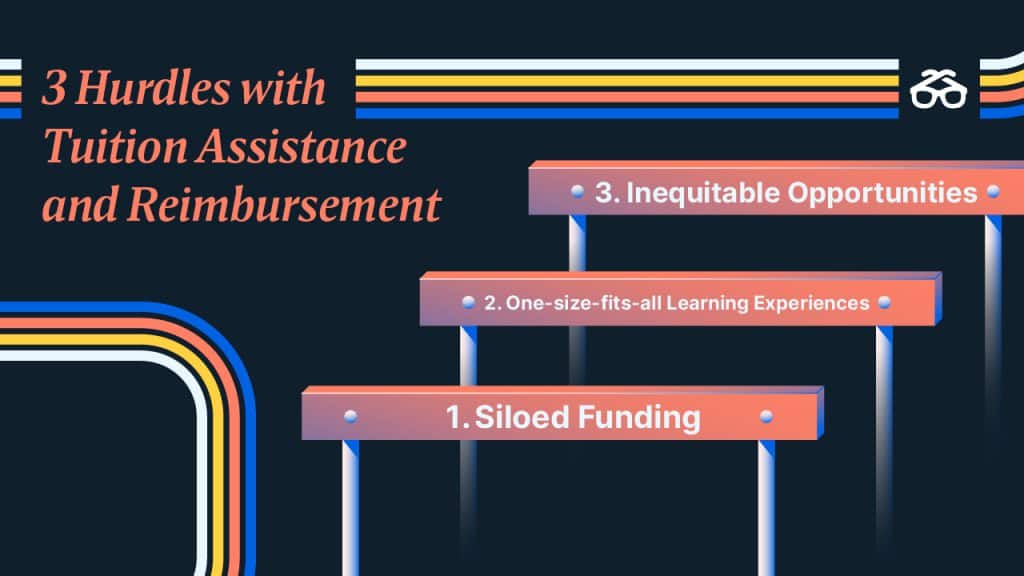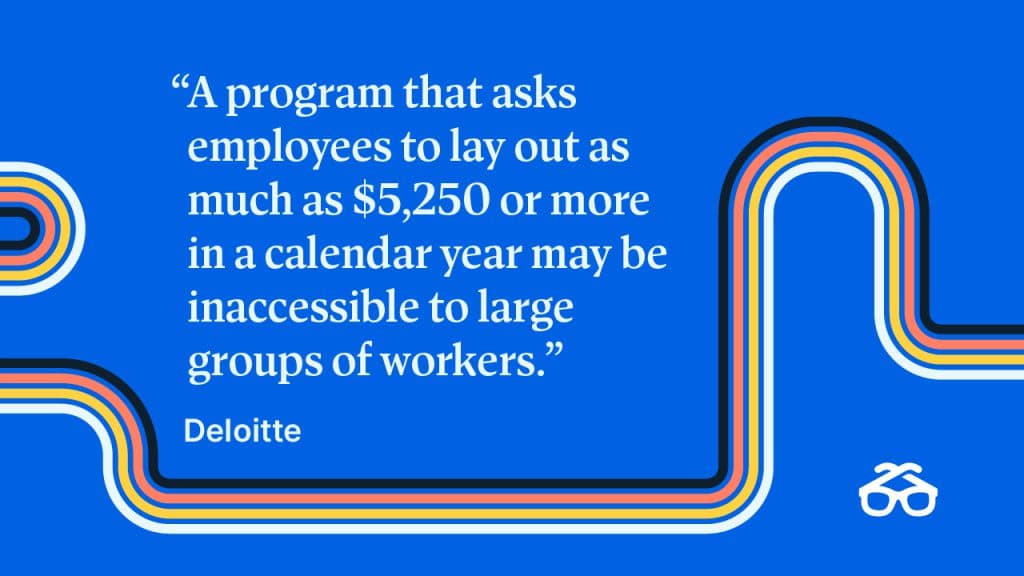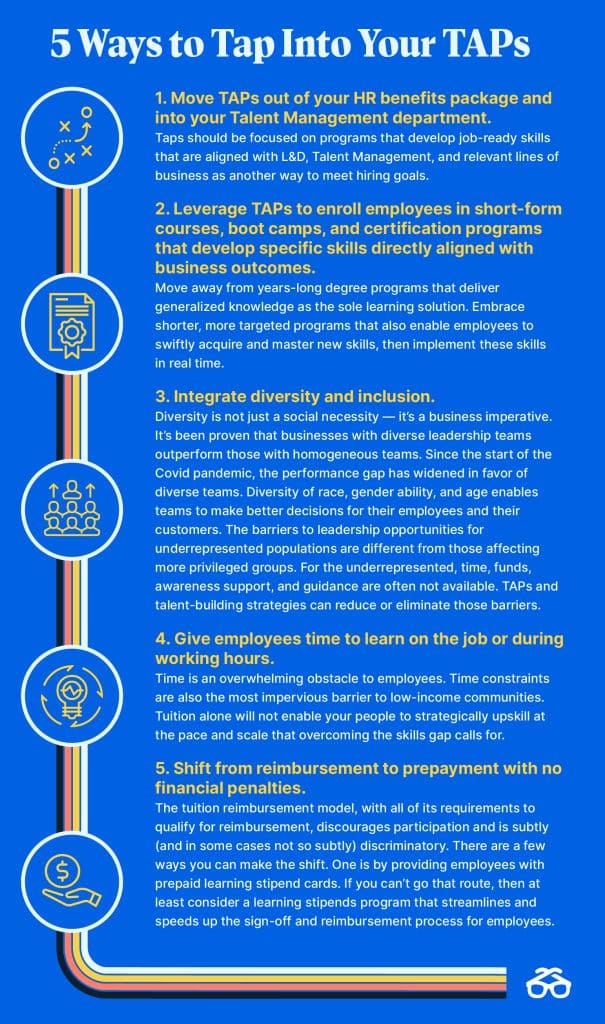Using tuition assistance or reimbursement benefits is about as modern as using a fax machine in today’s digital workplace. Since 1986, companies have offered employees on average $5,250 to enroll in further education, but only 5 to 10% of them take advantage of the opportunity. It’s an HR myth that tuition assistance is a widely-utilized benefit.
Can business leaders reimagine and modernize tuition assistance programs (TAPs) so they benefit every employee rather than a select few? Yes, it just takes a little work and innovative thinking, but the payoff is undeniable.
Modernizing tuition assistance and reimbursement benefits your company and employees by making it easier for them to upskill, remain relevant, and grow in their careers. Not to mention that when you reimagine outdated education funding, your company can close its skill gaps and boost retention.
If your business ranks among the 47% of companies offering undergraduate or graduate school tuition assistance to employees, or if you offer some form of reimbursement-based learning program, we explain why that’s more than likely a problem, and provide five alternate solutions.

The Big Hurdles with Tuition Assistance and Reimbursement
What parts of your tuition assistance and reimbursement need modernizing? It’s likely there are several obstacles that could be hindering your upskilling and retention success. Here are the common issues you need to solve first.

Hurdle 1: Siloed Funding
The primary problem with TAPs for mid-size and enterprise businesses is siloed funding. If yours is a small business with one person running HR, then siloed funding won’t be an issue. (SMBs, feel free to skip ahead to the next hurdle). But the larger your organization, the more disjointed funding becomes.
Most tuition assistance funds often roll up into HR, and this means L&D can’t to use these dollars for critical upskilling initiatives. This leads to U.S. employers spend $22 billion each year on TAPs, but according to the Lumina Foundation, just 2.5% measure the ROI of these programs or align them with broader talent-building initiatives. Ideally, this significant investment should be directed more effectively towards upskilling initiatives.
Hurdle 2: One-size-fits-all Learning Experiences
Along with aligning funding with upskilling initiatives, companies must modernize how they spend these funds. Today, because of how it started, tuition assistance is primarily used for traditional formal education programs like MBAs. But in order to fully address the skills gap, learning benefits should prioritize faster, skills-based learning experiences.
While traditional programs have a time and place, they’re not always focused on the skills your business needs. Only 11% of employers surveyed told Gallup that new graduates have the necessary skills for their businesses. Before you think this is just business owners being cynical, consider that the American Association of Colleges and Universities agrees. An AAC&U survey found just 25%of employers say new grads have the necessary skills for their jobs. Combined with today’s rapid pace of technological advancement, two- and four-year colleges and university programs can’t keep up.
So why are businesses sending employees to programs that aren’t delivering a stronger workforce?
To be fair, many of today’s opportunities such as boot camps and short courses didn’t exist as recently as the 1970s when tuition benefits became law. But now there is a growing awareness that adults learn faster in blended work-learning environments, where new skills and knowledge can be applied immediately and retained more quickly. It’s an easy fix: diversify. Luckily, the tax benefits typically used for traditional degrees also qualify for a variety of shorter and skills focused programs like bootcamps and certification programs.
Hurdle 3: Inequitable Opportunities
In addition to misaligned funds and unimaginative applications, most TAPs are inherently biased. The sheer size of the skills gap doesn’t give any wiggle room — everyone needs to upskill. If business leaders don’t make upskilling accessible to every employee, the job won’t get done.
How do traditional tuition assistance and reimbursement programs exclude employees? They’re biased toward workers privileged to have the discretionary time and money to use them. And they favor people who have a support network that enables education to be a priority.

Tuition assistance may work for management consulting firms that want elite pedigreed MBAs who will graduate and return to attractive salaries. But for the majority of employees, TAPs make little practical sense. Deloitte drew a similar conclusion: “Such a program [TAPs] is more likely to be attractive to and used by more highly compensated employees — whom it could be argued to have a less pressing need for such a program in the first place.”
To find out just how inequitable tuition assistance programs are, read “Why Your Tuition Reimbursement Benefit is Hurting Your DEIB Strategy.”
Remove Hurdles & Upskill Equitably
TAPs were invented for a different era when degree programs were the primary pathway to business skills, and these skills remained relevant for decades. The digital revolution, or what the World Economic Forum (WEF) calls the Fourth Industrial Revolution, is changing how people learn, what they need to learn, and the rate at which they need to learn new competencies.
In January 2023, the WEF estimated that some 1.1 billion jobs are liable to be radically transformed by technology in the next decade. That’s already a staggering number but also take into consideration that the report came out before the generative artificial intelligence blew up in March 2023. Now, the CEO of IBM is telling The Washington Post that the tech giant could replace 7,800 jobs with artificial intelligence.
Undeniably, business leaders have a skills emergency on their hands, and businesses of all sizes feel the skills pinch. In fact, 87% of executives told McKinsey that they were experiencing skill gaps in the workforce, but less than half of them had a clear sense of how to address the problem. Skills will become a major constraint akin to recent shortages of microchips for a wide range of businesses from smartphone manufacturers to automobile makers. Businesses need to invest in talent-building at scale or risk falling behind those that do.
TAPs — or more precisely, reimagined education benefits in the form of dedicated learning funds — can and should be powerful tools for your employees and businesses. By seamlessly integrating these learning benefits into your business’s comprehensive talent-building strategy, and aligning them with key performance indicators (KPIs), you can unlock the potential of your workforce to transform itself. When done right, learning benefits and talent-building can also become a diversity engine that further accelerates business performance. To get there, let’s explore five recommended changes to the traditional TAP model.

5 Ways to Tap Into Your TAPs
- Move TAPs out of your HR benefits package and into your Talent Management department. Taps should be focused on programs that develop job-ready skills that are aligned with L&D, Talent Management, and relevant lines of business as another way to meet hiring goals.
- Leverage TAPs to enroll employees in short-form courses, boot camps, and certification programs that develop specific skills directly aligned with business outcomes. Move away from years-long degree programs that deliver generalized knowledge as the sole learning solution. Embrace shorter, more targeted programs that also enable employees to swiftly acquire and master new skills, then implement these skills in real time.
- Integrate diversity and inclusion. Diversity is not just a social necessity — it’s a business imperative. It’s been proven that businesses with diverse leadership teams outperform those with homogenous teams. Since the start of the Covid pandemic, the performance gap has widened in favor of diverse teams. Diversity of race, gender ability, and age enables teams to make better decisions for their employees and their customers. The barriers to leadership opportunities for underrepresented populations are different from those affecting more privileged groups. For the underrepresented, time, funds, awareness support, and guidance are often not available. TAPs and talent-building strategies can reduce or eliminate those barriers.
- Give employees time to learn on the job or during working hours. Time is an overwhelming obstacle to employees. Time constraints are also the most impervious barrier to low-income communities. Tuition alone will not enable your people to strategically upskill at the pace and scale that overcoming the skills gap calls for.
- Shift from reimbursement to prepayment with no financial penalties. The tuition reimbursement model, with all of its requirements to qualify for reimbursement, discourages participation and is subtly (and in some cases not so subtly) discriminatory. There are a few ways you can make the shift. One is by providing employees with prepaid learning stipend cards. If you can’t go that route, then at least consider a learning stipends program that streamlines and speeds up the sign-off and reimbursement process for employees.
To learn more about using stipends and how to modernize your tuition assistance and reimbursement programs, download a free copy of “Rethink Your TAPs: Empowering Small and Medium-sized Businesses with Quick and Equitable Upskilling.”

